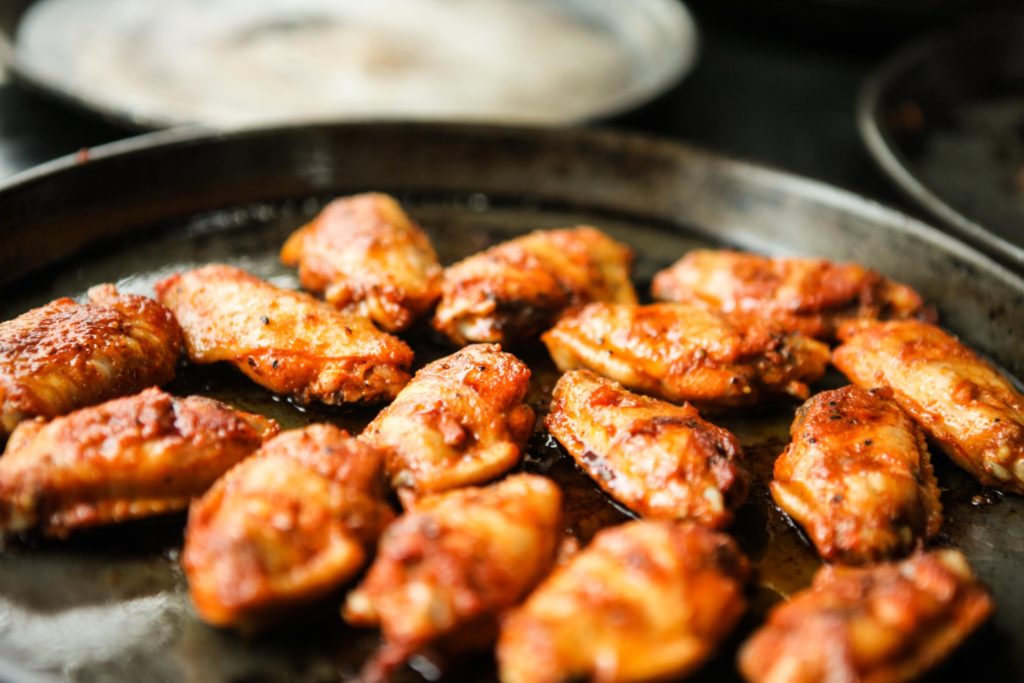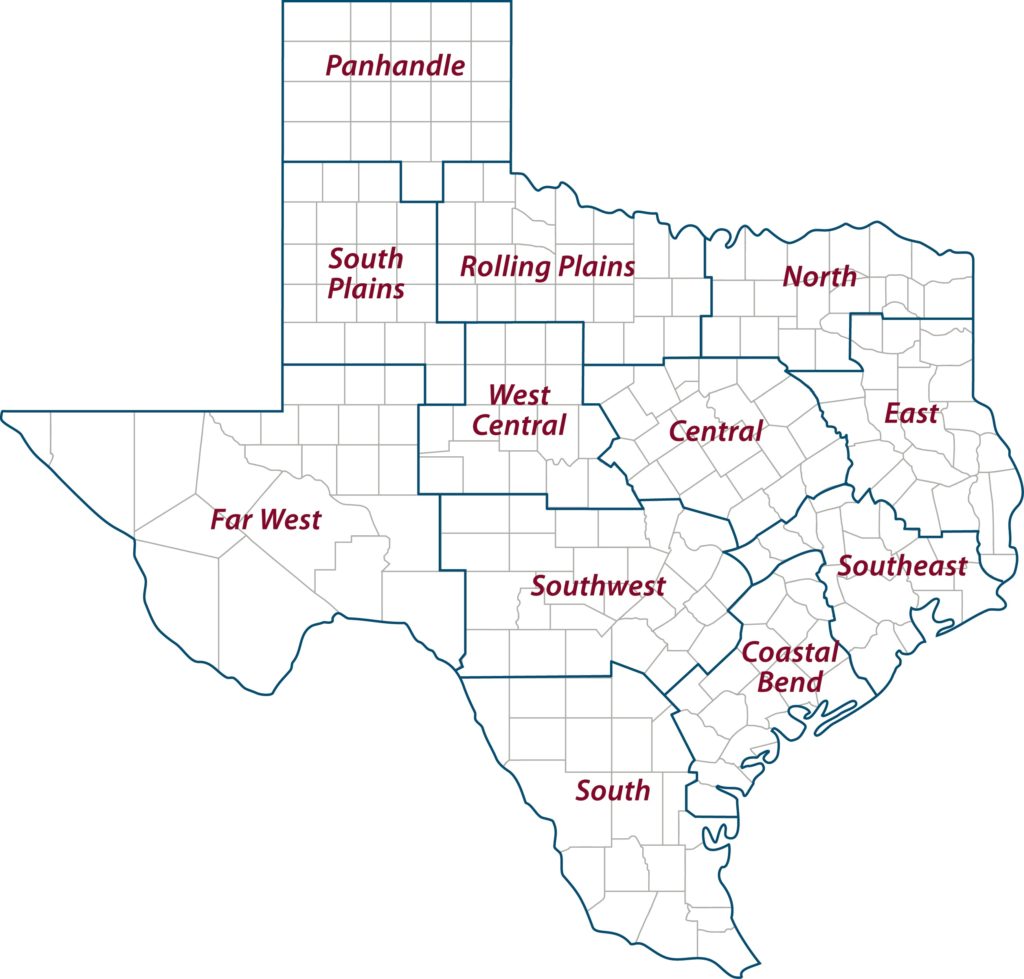Chicken wings defy pandemic on road to Super Bowl
Texas Crop and Weather Report – Feb. 2, 2021
Sales of chicken wings are expected to set another Super Bowl record despite reduced poultry production and an ongoing pandemic, according to both a Texas A&M AgriLife Extension Service expert and poultry trade association.
The National Chicken Council estimates consumption of chicken wings and drumsticks, a favorite snack for sports fans during Super Bowl week, will remain hot despite the pandemic. The council estimates a record 1.42 billion wings and drums, up 2% from last year, will be consumed as the Kansas City Chiefs take on the Tampa Bay Buccaneers.
David Anderson, Ph.D., AgriLife Extension economist, Bryan-College Station, said there are several aspects of the supply and demand spectrum that may have contributed to chicken wings performance despite COVID-19 restrictions.
Anderson said demand for wings is usually higher during football season, leading up to peak demand on Super Bowl Sunday.
“We normally see price increases due to demand this time of year,” he said. “You have playoff football and the Super Bowl, and wings have become synonymous with the activities surrounding these big sporting events. Wings and football just go together.”
Chicken wings flying high
Wholesale chicken wing prices are more than 50 cents higher per pound than this time last year at $2.49 per pound compared to $1.85 per pound, he said. The bounce in prices is even more impressive given the poultry product’s rebound from 91 cents per pound in April as COVID-19 led to widespread restrictions that closed restaurants and bars or reduced their capacity.
Wings bounced back to $1.80 per pound by May, but overall poultry production decreased for the last three quarters of 2020 due to uncertainty. An influx of wings and drums from cold storage more than made up for the reduction in production.
According to Cold Storage Reports, surplus wing and drum stocks in cold storage were reduced by 53% during November and December, as restaurants and retailers prepared for the typical rise in demand culminating with this year’s Super Bowl.
Anderson suspects typical restaurants that serve wings were suited for takeout and delivery, which likely shielded the poultry cut from the pandemic.
Servings of chicken wings in restaurants were up 7% in 2020 compared to 2019 despite an 11% decline in trips to commercial restaurants over the same time period, according to the council’s report.
A recent survey by the council showed COVID-19 didn’t slow down demand for chicken wings and that 25% of respondents consumed more wings and drums during the pandemic.
“Wings travel well and hold up during delivery conditions,” said council spokesman Tom Super. “Plus, they align with consumer desire for comfort food during the pandemic.”
But the council also reported higher demand for wings at grocery stores. Total U.S. wing retail/supermarket sales were up 10.3%, almost $3 billion, and in-store frozen wing sales were up more than 37%.
Anderson said the boom at grocers is not surprising because retail sales of all meats has spiked during the pandemic, though the increase has not made up for the reduction in restaurant sales for those products.
Technological twist, longing for normalcy
Anderson said cooking technology – specifically the air fryer – also may have contributed to the spike in grocer sales.
“The popularity of air fryers is trending high, and their popularity has changed the demand for a meat item much like the microwave did for breaded chicken and nuggets years ago,” he said. “The microwave changed the way we eat chicken, and the air fryer makes preparing wings at home easier and more convenient. It’s an interesting twist to how wings are performing this year in spite of COVID-19.”
Anderson said demand for chicken wings could be a sign that people are hungry for normalcy and ready for gatherings and the foods associated with socializing. He suspects there could be a boom in pent-up demand for even more wings and drums as vaccinations spread.
Rising feed costs including corn and soybean meal, staples for poultry production, could reduce production and might impact prices later this year, Anderson said.
“Here we are at really high prices, but it’s a combination of a little less supply and higher demand and a litany of seasonal and coincidental factors,” he said. “There are so many factors that are weighing into the market for chicken wings this year – from COVID-19 to technology – and that makes it interesting from an economist standpoint.
“I wouldn’t doubt that the Buffalo Bills’ success and making the AFC Championship contributed somewhat to its own little spike to the chicken wings’ overall success because of the city’s association with Buffalo-style hot wings.”
AgriLife Extension district reporters provide a look at weather and agriculture conditions around the state
CENTRAL
Light, showery conditions throughout the week maintained good topsoil moisture. Wet, cold conditions increased feeding requirements for beef herds. Some herds were expected to begin calving season soon. Pecan harvest neared completion. Small grains looked very good. Producers reported heavy rust infestations due to weather conditions. Herbicide applications were underway due to heavy winter annual weeds, rye and henbit in winter wheat fields. Winter wheat emergence was patchy in most fields, which contributed to weed competition. Earlier planted oat and rye fields were developing well, and some were being grazed. Most winter forages needed more growth, and livestock were being fed hay. Livestock were in good condition. Field preparation was progressing well, including more fertilizer applications. Nearly all the counties reported adequate soil moisture levels. More than half of the district reported good overall pasture and rangeland conditions.
ROLLING PLAINS
Much of the district received much-needed rain with some areas reporting 0.5 to 2 inches of rainfall. Winter wheat conditions were gradually improving. Cattle producers continued supplementing livestock and cow-calf and stocker operations with protein supplements and hay where forages were limited.
COASTAL BEND
Warmer-than-average temperatures were drying fields, and there were long-range forecasts for warmer weather. Many farmers were preparing equipment and deciding when to begin planting corn. Most were expecting to have crops in by mid-February. Farmers were able to enter fields with lighter, sandier soils to catch up on weed control and bed preparation. Weed control was limited to aerial applications on heavier soils due to moisture. Some producers were applying preplant fertilizer. Winter pastures improved some following sunny, warmer days. Overall, winter pasture growth was fair to poor due to later than normal planting and drier than normal conditions at prime planting time. Livestock remained in good condition and were being supplemented with hay and protein. Some producers were still pulling calves off cows and weaning.
EAST
Winter cover crops looked much better after rains swept through the district. Pond water levels were up. Some areas were still extremely wet. Pasture and rangeland conditions were fair. Subsoil and topsoil conditions were adequate. Livestock were in fair to good condition with supplemental feeding taking place. Cattle markets were up, and producers were hopeful for the future. Feral hogs remained a problem for most producers. Gopher control was underway in Gregg County.
SOUTH PLAINS
Temperatures were mild with high winds reported. A few light showers were reported across the district, but significant rainfall was still needed for farmers to plant in the spring. Producers were preparing for planting season and preparing the soil with irrigation where they could. Cattle were on supplemental feed due to drought conditions.
PANHANDLE
Topsoil and subsoil moisture levels were short to very short. Pastures and rangeland were reported as very poor to fair. Winter wheat conditions were poor to good. Additional precipitation was needed to boost soil moisture for small grains, rangelands and pastures. Compost and manure were being applied to fields, but little fieldwork was being done. Some producers were running pivots to irrigate wheat for cattle.
NORTH
Topsoil moisture throughout the district was mostly adequate. Temperatures were a little cooler earlier on in the reporting period with a few days in the 40s and lows in the 20s. Up to half an inch of rainfall was reported with very windy conditions at times. Wheat conditions worsened, but some sunshine could help. Ryegrass started to pop out. Livestock were in good condition. Calving season was beginning and conditions were moderate to mild so far for cattle this winter. Hay feeding continued. Feral hog signs and sightings continued to increase especially with soil moisture and sunshine. Ponds were full.
FAR WEST
Temperatures were in the mid-30s overnight and mid-60s during the day. Trace amounts of rain were reported. High winds were depleting topsoil moisture. Wheat planted in the fall finally emerged as moisture and soil temperatures were favorable. Fieldwork was minimal. Pastures contained very little grass or weeds. Pecan producers were trying to finish up harvest. Beef cattle producers were still working early fall calves and sorting cows to prepare for spring rotation and breeding season. Producers continued to feed livestock and wildlife.
WEST CENTRAL
Moisture conditions improved. Pastures showed some signs of green-up, but there was still very little forage available, so producers were feeding hay and supplements. Wheat fields that did not germinate at planting were emerging. Fieldwork started for spring planting. Cattle markets were steady to higher on all classes.
SOUTHEAST
Conditions were starting to dry out with another week of little to no rain and cooler temperatures in the forecast. Pasture and livestock conditions remained decent. Rangeland and pasture ratings were excellent to very poor with fair ratings being the most common. Soil moisture levels ranged from adequate to surplus with adequate being the most common.
SOUTHWEST
Moisture conditions were declining across the district. Temperatures remained mild with plenty of sunshine. Fertilization of cropland continued. Winter wheat under irrigation continued to progress. Rangeland and pasture conditions were improving. Caldwell County reported livestock markets were low. Most sheep and goats were bred, and lambing and kidding should begin soon. Supplemental feeding for livestock and wildlife continued.
SOUTH
Soil moisture levels were adequate in a few areas but short to very short in most counties. Conditions were windy in some areas. Temperatures were mild overall with trace amounts of rain reported in a few areas. Pasture and rangeland conditions improved following recent rainfall events. Wheat and oat planting continued. Duval County reported emerged oat fields were improving. Producers continued to provide supplemental feed for livestock. Bermuda grass remained dormant. Producers in some areas reported cattle body condition scores were declining without heavy supplemental feeding. Some areas reported invasive weeds and grasses were growing. Not much fieldwork occurred due to dry conditions, but some producers were preparing soil for planting. Hay bales were about $65 for round bales. Zapata County reported high wildfire risk. Farmers with the ability to irrigate continued pre-watering their fields for planting soon. Some farmers who irrigated early will be planting corn or grain sorghum in the next few days. Cotton planting should begin later in the month. Citrus and sugarcane harvest continued, and vegetables were also being harvested.




